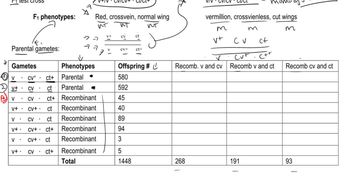The following table shows data from a cross (ABC x abc) examining three genes (a, b, and c). Calculate the recombination frequency for A and B
Table of contents
- 1. Introduction to Genetics51m
- 2. Mendel's Laws of Inheritance3h 37m
- 3. Extensions to Mendelian Inheritance2h 41m
- 4. Genetic Mapping and Linkage2h 28m
- 5. Genetics of Bacteria and Viruses1h 21m
- 6. Chromosomal Variation1h 48m
- 7. DNA and Chromosome Structure56m
- 8. DNA Replication1h 10m
- 9. Mitosis and Meiosis1h 34m
- 10. Transcription1h 0m
- 11. Translation58m
- 12. Gene Regulation in Prokaryotes1h 19m
- 13. Gene Regulation in Eukaryotes44m
- 14. Genetic Control of Development44m
- 15. Genomes and Genomics1h 50m
- 16. Transposable Elements47m
- 17. Mutation, Repair, and Recombination1h 6m
- 18. Molecular Genetic Tools19m
- 19. Cancer Genetics29m
- 20. Quantitative Genetics1h 26m
- 21. Population Genetics50m
- 22. Evolutionary Genetics29m
4. Genetic Mapping and Linkage
Trihybrid Cross
Problem 8g
Textbook Question
Determine whether the statements below are true or false. If a statement is false, provide the correct information or revise the statement to make it correct.
The progeny of a trihybrid cross are expected to have one of 27 different genotypes.
 Verified step by step guidance
Verified step by step guidance1
Step 1: Understand the concept of a trihybrid cross. A trihybrid cross involves three traits, each controlled by a pair of alleles. For example, AaBbCc x AaBbCc represents a trihybrid cross.
Step 2: Recall the formula for calculating the number of possible genotypes in a cross. The number of genotypes is determined by the formula \(3^n\), where \(n\) is the number of traits being considered. In this case, \(n = 3\).
Step 3: Substitute \(n = 3\) into the formula \(3^n\). This calculation represents the total number of genotypes expected in the progeny of a trihybrid cross.
Step 4: Evaluate whether the statement 'The progeny of a trihybrid cross are expected to have one of 27 different genotypes' aligns with the result of the formula \(3^n\). If \(3^3 = 27\), the statement is true. If not, revise the statement accordingly.
Step 5: If the statement is false, provide the correct information. For example, if the number of genotypes differs, explain the correct calculation and clarify the expected number of genotypes in the progeny of a trihybrid cross.
 Verified video answer for a similar problem:
Verified video answer for a similar problem:This video solution was recommended by our tutors as helpful for the problem above
Video duration:
1mPlay a video:
Was this helpful?
Key Concepts
Here are the essential concepts you must grasp in order to answer the question correctly.
Trihybrid Cross
A trihybrid cross involves the genetic crossing of organisms that are heterozygous for three different traits. Each trait is typically represented by two alleles, leading to a combination of alleles in the offspring. The expected genotypic ratio can be calculated using the principles of Mendelian genetics, specifically the product rule for independent assortment.
Recommended video:
Guided course

Trihybrid Cross
Genotype
Genotype refers to the genetic constitution of an organism, specifically the alleles present at a given locus. In a trihybrid cross, each of the three traits can be represented by two alleles, resulting in a variety of combinations. The total number of different genotypes can be determined by calculating the combinations of alleles from each trait.
Recommended video:
Guided course

Gamete Genotypes
Independent Assortment
The principle of independent assortment states that alleles for different traits segregate independently during gamete formation. This means that the inheritance of one trait does not affect the inheritance of another. In a trihybrid cross, this principle allows for the calculation of the total number of possible genotypes, which is 2^n, where n is the number of traits being considered.
Recommended video:
Guided course

Gamete Genetics and Independent Assortment
Related Videos
Related Practice
Multiple Choice
1036
views
6
rank
2
comments


